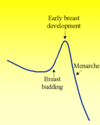Growth and Development Flashcards
(34 cards)
What do we measure for growth in children?
- Height
- Length
- Sitting height
- Head circumference
Growth charts (later)
- LATER
How do we stage puberty?
- Tanner method

What is important in history and examination when establishing growth and development?
- Birth weight and gestation
- Past medical history
- Family history/ social history/ schooling
- Systematic enquiry
- Dysmorphic features
- Systemic examination
What assessment tools do we use for growth???

What are the factors influencing height?
- Age
- Sex
- Race
- Nutrition
- Parental heights
- Puberty
- Skeletal maturity
- General health
- Chronic disease
- Specific growth disorders
A normal growth curve includes what 3 stages?
- Infantile
- Childhood
- Pubertal

The following changes occur in boys during puberty:
- Advanced changes of puberty
- Faical hair and shaving
- Onset of testicular growth
- Penile growth


The following changes occur in girls during puberty:
- Breast budding
- Early breast development
- Menarche
Label these on the diagram below:


What are the most important pubertal stages in:
(a) A girl
(b) A boy
(a) Breast budding (Tanner Stage B2)
(b) Testicular enlargement (Tanner Stage G2 T3-4ml)
Which growth disorders would be an indication for referral
Growth disorders: Indications for referral:
- Height below target height
- Abnormal height velocity (crossing centiles)
- Extreme short or tall stature (off centile)
- History of chronic disease
- Obvious dysmorphic syndrome
- Early/ late puberty
State the ages of both early and delayed puberty in:
(a) Boys
(b) Girls
Early and delayed puberty:
(a) Boys: early < 9 years, delayed > 14 years
(b) Girls: Early < 8 years, delayed > 13 years
Constitutional Delay of Growth and Puberty (CDGP):
(a) Who is mainly affected
(b) What part of the history is important
(c) What is the cause
Constitutional delay of bone growth
(a) Mainly occurs in boys
(b) With a family history in the dad or brothers
(c) This occurs due to bone age delay
State some causes of delayed puberty
Causes of delayed puberty:
- Gonadal dysgenesis (Turner 45X, Klinefelter 47XXY)
- Chronic disease (Crohn’s, asthma)
- Kallman’s syndrome
- Cryptochidism (one of both testes fail to descend from the abdomen into the scrotum)
What are the causes of early breast development?
Causes of early breast development:
- Infantile thelarche
- Premature thelarche (thelarche = onset of secondary breast development. This should occur at the beginning of puberty)
- True central precocious puberty (condition that causes early sexual development in children)

What are the causes of early secondary sexual characteristics?
- Exaggerated adrenarche (adrenarche is a stage in sexual maturation that is involved in the development of pubic hair, body odour, skin oiliness and acne)
- Precocious pseudopuberty (puberty occurring at an unsually early age i.e production of oestrogen in prepubertal girls)

What is the cause of early PV bleeding (vaginal bleeding)
Cause of early PV bleeding (vaginal bleeding):
- Premature menarche (menarche = first menstrual cycle)

How does central precocious puberty present?
Central precocious puberty presentation:
- Breast development in girls
- Testicular enlargement in boys
- Growth spurt
- Advanced bone age
How is central precocious puberty treated?
Treatment for central precocious puberty:
- GnRH agonist (gonadotropin - releasing hormone agonist)
Precocious Pseudopuberty (later)
LATER
What is the management approach for a baby with ambiguous genitalia?
Management Approach:
- DO NOT guess the sex of the baby
- Multidisciplinary approach
- Examination of the gonads and internal organs
- Karyotype
- Exclude Congenital Adrenal Hyperplasia
What are the causes of congenital hypothyroidism?
Congenital causes:
- Athyreosis (thyroid gland has failed to develop properly)
- Hypoplasia (thyroid gland has failed to develop properly)
- Ectopic
- Dyshormonogenic (genetic defects in the synthesis of thyroid hormones)
How can we detect congenital hypothyroidism in a newborn?
- Newborn screening
How do we treat congenital hypothyroidism?
- Start treatment within first 2 weeks




